Musicarta Pentatonics Workbook
Major and Minor Pentatonic Scales
on the Same Root
The story so far...
So far in our exploration of the pentatonic scales, we have built the pentatonic major scale
- From the classical seven-tone major scale and
- By counting semitones.
Then we discovered pairs of major and 'relative minor' pentatonic scales which use the same set of five pentatonic scale-tones.
Now, we must complete the process by learning to build both major and pentatonic minor scales on the same root (home-note) - 'parallel' pairs.
Learning to build both major and minor pentatonic scales on the same root quickly teaches you the all-important distances (intervals) between the scale tones. When you know those, you will be able to use the pentatonic scales a lot more easily in your keyboard improvising.
The following section is from Musciarta's pre-video audio archive. Try it! (Or you can skip down to the pictures section.)
Intervals in the pentatonic scales
Here is a column diagram representing both major and minor pentatonic scales built on the same root.
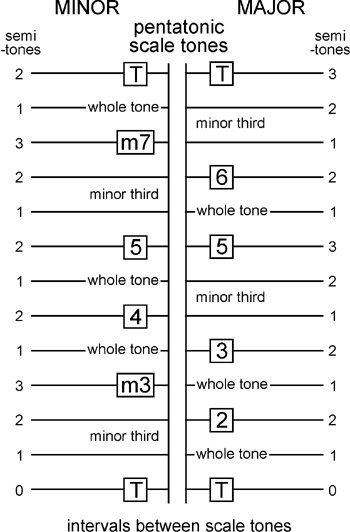
Looking at the diagram, you can see that the pentatonic scale-tones in both the major and minor pentatonic scales are either one whole tone (two semitones) or a minor third (three semitones) apart.
Let’s look at some keyboards with the intervals (distances) counted off in semitones.
There are two things to remember when you count semitones.
- You count semitones at the back of the keys so you include both black and white keys (indicated ‘always semitones’ in the first diagram.).
- You count semitones from zero.
Here is a major pentatonic scale - C major pentatonic. It's an all-white-key pentatonic scale.
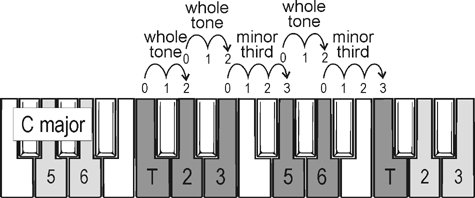
Note: The audio files play only the six darker-shaded notes, up and down, twice. Count the semitones off, trying to hear the two different ‘sizes’ of the steps. Sing along, and follow at the keyboard too.
When we move to the 'parallel' (built on the same root) minor pentatonic scale, we find we have two black keys.
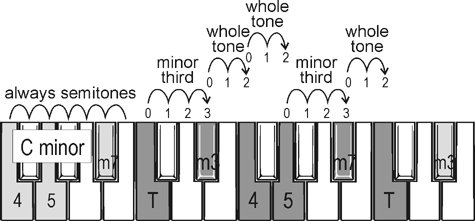
Here is another pair of scale. We start a minor scale this time - all-white-key E minor pentatonic.
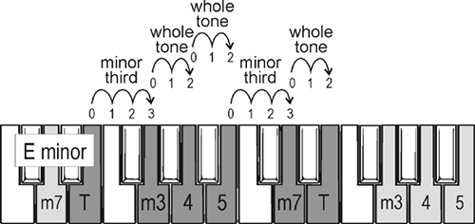
The parallel major pentatonic has three black keys.
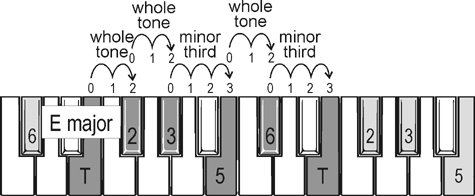
The intervals in music manuscript
Now here are the four scales in music manuscript.
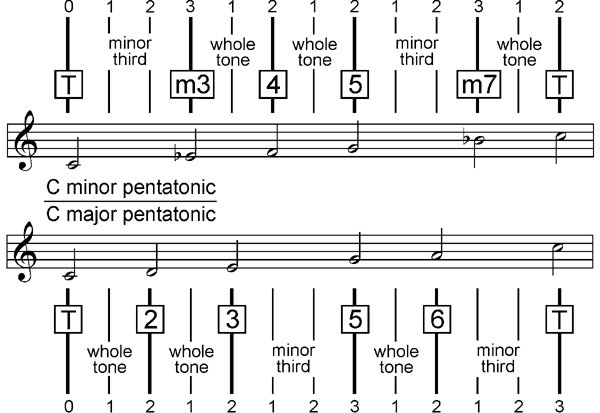
The audio file plays the minor scale up and down, then the major, then it repeats. Use it for ear-training.
Make sure you see how both the counted-off keyboards and the music manuscript ‘tell the same story’.
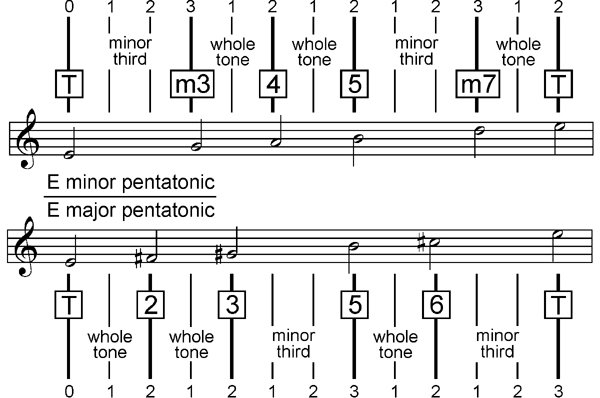
Here are some tasks to check your understanding so far.
- Count off the four pentatonic scales above at the keyboard.
- See if you can count off major and minor pentatonic scales from any random note.
And now for the video.
Parallel major/minor pentatonic scale pairs
Here's a video which demonstrates how pentatonic major and minor scales are built up from the same root.
The scales - Group 1
The scales are split up into three groups or easy of navigation and to help you structure your practicing.
Group 2
Group 3
Keep coming back until you know these scales without having to think about it. (It's not that big a task, really...!)
Your practical knowledge of intervals and 'what the keyboard sounds like' will benefit massively.
The twenty-four one-octave pentatonic scales
At some point you will want to play through all twenty-four major and minor pentatonic scales systematically. The aim would be to get used to the sound of the major and minor pentatonic scales and to learn to ‘see’ the intervals (distances) within the pentatonic scales. You would do that in order to learn to use pentatonic scales at the keyboard (on any note) in your creative work.
This Musicarta module offers the twenty-four scales arranged in two ways. Open and print these two pdf files.
About the PDF music files
Looking at the scales in the music, you see that no fingering is given. You use any convenient fingering, or use two hands, playing the bottom three notes with the left hand and the top three notes with the right hand. The purpose is to find the scale tones, not play them at speed.
The scales are written without key signatures, so the sharps and flats in the music indicate which notes use black keys. Also, every black key has a sharp or flat in front of it – you will not normally see accidentals repeated in the same bar like this.
Take note of the two ‘interval reminders’ at the top of the page. The major interval reminder is placed above the major pentatonic scales on the left hand side of the page, and the reminder for the minor pentatonic scale over the minor scales on the right.

Lastly, don’t get hypnotised by the ‘dots’! A glance at the interval reminders every now and then will help you remember the pentatonic shorthand and how many semitones there are between the scale tones, and remind you that this is a knowledge-building exercise, not a mechanical finger exercise.
Same root major/minor pairs
Working with the ‘same root’ version of the scales first, play right through the twenty-four scales. Divide the job up into sections to keep your attention fresh. Try to play the scales from your knowledge of the intervals.
If you can read music at sight, pay particular attention to learning the patterns and building the scales accordingly. It’s probably better to be not such a good reader – you will use the semitone counting in the interval reminders (plus, of course, your ear) to help you find the scale tones. This is far more use to you creatively than reading the music.
You should anticipate spending a lot of time on this. Remember that in the end you want to be able:
- to build both pentatonic major and minor scales at the keyboard on any note (quickly!);
- to hear pentatonic riffs in your head and name the notes using the pentatonic shorthand, and
- to play at the keyboard any pentatonic music you hear in your head or on disc.
That’s not a done-it-once-and-move-on task!
Ear training tasks
Train yourself to sing the pentatonic scales. Sing along with any (or all) of the audio clips in the Musicarta Pentatonic Scales lessons, both with your eyes closed and looking at the many examples of pentatonic shorthand (T, m3 etc.). Your singing doesn’t have to be in tune – it’s not for public consumption. Just the relative size of the gaps has to be clear in your mind.
Test your progress by seeing if you can pick out the major and minor pentatonic scale tones ‘by ear’ with your eyes closed from a random white piano key.
|
OUT NOW! |
THE MUSICARTA BEAT & RHYTHM WORKBOOK At last! An effective approach to keyboard rhythm & syncopation skills. Learn more! |
ONLY $24.95! |
|
THE MUSICARTA PENTATONICS WORKBOOK video course
Introductory
Practice Patterns
Melody Work and
Playing by Ear
Pentatonic Riffs
and Diaries - Minor Pentatonic Major Pentatonic
Chromatic Minor
Chromatic Major
Pre-video Pages
Pentatonics videos
Archive Pages
|
The MusicartaA methodical approach to keyboard syncopation for
|
PUBLICATIONS
exciting keyboard
creativity courses
CHORDS 101
WORKBOOK

~HANON~
video course

Musicarta
Patreon
PENTATONICS
WORKBOOK
video course

Creative Keyboard
video course

BEAT AND RHYTHM
WORKBOOK

- Volume 1 -

12-BAR PIANO
STYLES WORKBOOK

MUSICARTA MODES
WORKBOOK

PIANO STYLE

CANON PROJECT
video course

VARIATIONS
video course


- Piano Solo -
video course

- Piano Solo -


YouTube playlists





 THE LOGO
THE LOGO
